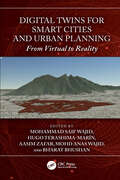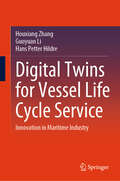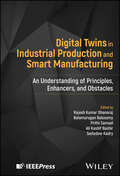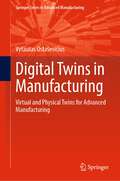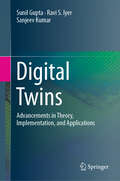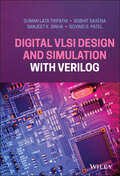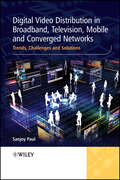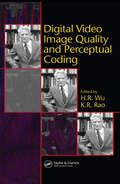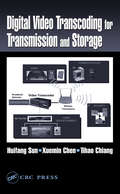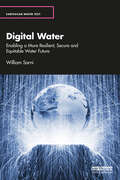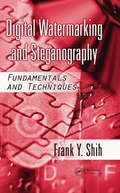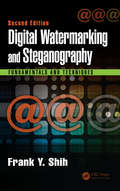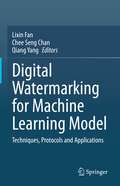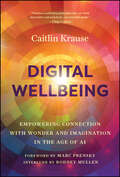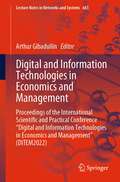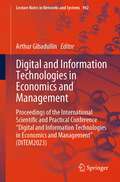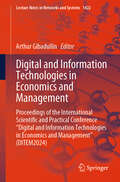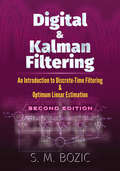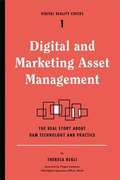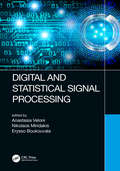- Table View
- List View
Digital Twins for Smart Cities and Urban Planning: From Virtual to Reality
by Bharat Bhushan Mohd Anas Wajid Aasim Zafar Mohammad Saif Wajid Hugo Terashima-MarínThis book discusses the concept of the digital twin, which has the potential to change how systems are managed and created. It also discusses the metaverse as a new technology with literary roots, cross-platform avatars, and artificial intelligence-related cybersecurity risks.Digital Twin for Smart Cities and Urban Planning: From Virtual to Reality provides practitioners with concrete problem-solving methodologies while covering the most recent and cutting-edge digital twin application technologies in diverse fields. It highlights the benefits of digital twins in terms of data visualization, real-time data analytics, and learning, which leads to increased confidence in decision-making. The book discusses the metaverse as a new technology with literary roots, cross-platform avatars, and artificial intelligence-related cybersecurity risks. It also evaluates the opportunities that DT can provide for smart cities and discusses the prerequisites for secure, safe, and sustainable smart cities. It also explores the mix between the industrial Internet of Things, artificial intelligence, machine learning, and software analytics with spatial network graphs to construct living digital simulation models that update and alter in response to changes in their physical counterparts. The chapters also focus on digital twin driven smart design which establishes a foundation for the adoption of digital twin technology in product design by drawing on the most recent industry practice and research.The book is an excellent resource for practitioners and scholars in manufacturing, operations research, and communications who are thinking about digitizing their assets and related services. It is also a helpful resource for graduate students and academics looking to better understand pioneering digital twins technologies.
Digital Twins for Vessel Life Cycle Service: Innovation in Maritime Industry
by Guoyuan Li Houxiang Zhang Hans Petter HildreThis book introduces the development of the digital twin of the marine infrastructure in Norway, which will be a significant scientific and operational achievement for the industry, making efficient and safe offshore operations possible. It enables data exchange safely and easily between different sub-systems, modules, and various applications. A complete digital twin ship will be presented in details. Thus, the twin ship can provide an integrated view of the ship’s various physical and behavioral aspects in different stages, and allow simultaneous optimization of functional performance requirements. In addition, it enables advanced control and optimization, e.g., creating more reliable prediction for flexible objectives (time, output, emissions, fuel consumption), and executing day-ahead and long-term planning for operations. More importantly, several related applications and case studies are presented in the end to confirm the effectiveness of the digital twin system. The research work is not only interesting for academia, also for industry.
Digital Twins for Wireless Networks: Overview, Architecture, and Challenges
by Waleed Ejaz Muhammad Khalil Afzal Muhammad NaeemThe sixth-generation (6G) communication systems are anticipated to provide network connectivity for an extensive range of use cases in a variety of emerging vertical industries. Consequently, a new set of challenging requirements and more stringent key performance indicators have to be considered, a novel architecture has to be designed, and unique enabling technologies shall be developed in order to fulfil the technical, regulatory, and business demands of the communication service customers. 6G networks are expected to offer even faster speeds, lower latency, and greater capacity compared to 5G networks, which will enable new applications and use cases that are currently not possible. Improved quality of life by enabling various applications (emerging Internet of everything applications) such as healthcare, brain-computer interactions, and extended reality is the main focus of future wireless services. Quality of experience, latency, and reliability are the key requirements of these applications. To meet these diverse requirements there is a need to assist wireless systems with unique technologies. Self-sustaining wireless systems (intelligence, seamless and ubiquitous connectivity) and proactive-online-learning-enables systems (Intelligent analytics) are two trends in future wireless systems. The digital twin technology is one of the most promising technologies that can be instrumental in realizing the technical and business objectives of 6G communication systems. A digital twin is a virtual imitation of a physical object or system. In a wireless system, a digital twin can be used to model and analyse the behaviour of the network and its components, such as antennas, transmitters, receivers, sensors, and other devices in wireless networks. One of the key benefits of using a digital twin for a wireless system is that it can help network operators and engineers to optimize the performance of the wireless network by simulating different scenarios and configurations. Other benefits include improve efficiency, cost saving, and enhanced security. In 6G networks, a digital twin could be used to simulate and optimize the performance. This could include simulating different network topologies, testing the performance of different network protocols and algorithms, and optimizing the placement of network infrastructure. To create a digital twin of a wireless network, a detailed model of the network and its components must be developed, based on real-world data and conditions. This model can then be used to simulate the behaviour of the network under different conditions and settings and to visualize the results in real time.
Digital Twins in Industrial Production and Smart Manufacturing: An Understanding of Principles, Enhancers, and Obstacles
by Seifedine Kadry Balamurugan Balusamy Ali Kashif Bashir Rajesh Kumar Dhanaraj Prithi SamuelComprehensive reference exploring the benefits and implementation of digital twins in industrial production and manufacturing Digital Twins in Industrial Production and Smart Manufacturing provides an overview of digital twin theoretical concepts, techniques, and recent trends used to meet the requirements and challenges of industrial production and smart manufacturing. The text describes how to achieve industrial excellence through virtual factory simulation and digital modeling innovations for next-generation manufacturing system design. The contributing authors address the many possible technical advantages of major Industry 5.0 technological advancements, using illustrations to aid readers in practical implementation of concepts, along with existing scenarios, potential research gaps, adoption difficulties, case studies, and future research objectives. The text also presents many applications and use cases of Industry 5.0 and digital twins in a variety of industries, including the aerospace industry, pharmaceutical manufacturing and biotech, augmented reality, virtual reality, edge computing and blockchain-based Internet of Things (IoT), cobots, intelligent logistics and supply chain management, and more. Edited by a group of highly qualified academics with significant experience in the field, Digital Twins in Industrial Production and Smart Manufacturing covers additional topics such as: Hyper-automation technology, including specialized workflow procedures and particular sectors of solicitations linked to hyper-automationDigital twins in the context of smart cities, with attempts to draw comparisons with the use of digital twins in industrial IoTVirtual factories based on digital twins and corresponding architecture to facilitate modeling, simulation, and assessment of manufacturing systemsCognitive, interactive, and standardization aspects of digital twins, and the proper implementation of digital twin technology for safety critical systems Digital Twins in Industrial Production and Smart Manufacturing is a must-have reference for researchers, scholars, and professionals in fields related to digital twins in industrial production and manufacturing. It is also suitable as a hands-on resource for students interested in the fields of digital twins and smart manufacturing.
Digital Twins in Manufacturing: Virtual and Physical Twins for Advanced Manufacturing (Springer Series in Advanced Manufacturing)
by Vytautas OstaševičiusThis book presents a guide to digital twin technologies and their applications within manufacturing. It examines key technological advances in the area of Industry 4.0, including numerical and experimental models and the Internet of Things (IoT), and explores their potential technical benefits through real-world application examples. This book presents digital models of advanced manufacturing processes dynamics that enable to control the cutting processes including experimental and simulation studies for brittle-ductile transition of ultra-precision machining materials assuring product quality. Innovative electrical power harvesting solutions from tool vibrations and wireless data transmission from confined and heavily cooled environment are also included. It explains the benefits of virtual and physical twins adapted to real systems, including the ability to shorten the product's path to the market, and enabling the transition to higher value-added manufacturing processes. Including numerous illustrations and clear solved problems, this book will be of interest to researchers and industry professionals in the fields of mechatronics, manufacturing engineering, computational mechanics.
Digital Twins: Advancements in Theory, Implementation, and Applications
by Sunil Gupta Sanjeev Kumar Ravi S. IyerDigital twin technology has been rapidly evolving and gaining popularity in various fields such as manufacturing, energy, healthcare, and transportation. Digital twin is a virtual representation of a physical system or process that enables real-time monitoring, analysis, and optimization. This book will provide a comprehensive understanding of digital twin technology, its advancements, and applications. It will be useful for researchers, academics, practitioners, and students who are interested in the fields of engineering, computer science, data analytics, and Industry 4.0.
Digital Twins: Applications to the Design and Optimization of Bioprocesses (Advances in Biochemical Engineering/Biotechnology #177)
by Ralf Pörtner Christoph Herwig Johannes MllerThis is the second of two volumes that together provide an overview of the latest advances in the generation and application of digital twins in bioprocess design and optimization. Both processes have undergone significant changes over the past few decades, moving from data-driven approaches into the 21st-century digitalization of the bioprocess industry. Moreover, the high demand for biotechnological products calls for efficient methods during research and development, as well as during tech transfer and routine manufacturing. In this regard, one promising tool is the use of digital twins, which offer a virtual representation of the bioprocess. They reflect the mechanistics of the biological system and the interactions between process parameters, key performance indicators and product quality attributes in the form of a mathematical process model. Furthermore, digital twins allow us to use computer-aided methods to gain an improved process understanding, to test and plan novel bioprocesses, and to efficiently monitor them. This book focuses on the application of digital twins in various contexts, e.g. computer-aided experimental design, seed train prediction, and lifeline analysis. Covering fundamentals as well as applications, the two volumes offers the ideal introduction to the topic for researchers in academy and industry alike.
Digital Twins: Basics and Applications
by Zhihan Lv Elena FersmanThis book comprehensively introduces readers to Digital Twins, from the basic concepts, core technologies and technical architecture, to application scenarios and other aspects. Readers will gain a profound understanding of the emerging discipline of Digital Twins. Covering the latest and cutting-edge application technologies of Digital Twins in various fields, the book offers practitioners concrete problem-solving strategies. At the same time, it helps those working in Digital Twins-related fields to deepen their understanding of the industry and enhance their professional knowledge and skills. Given its scope, the book can also be used as teaching material or a reference book for teachers and students of product design, industrial design, design management, design marketing and related disciplines at colleges and universities. Covering a variety of groundbreaking Digital Twins technologies, it can also provide new directions for researchers.
Digital Twins: Tools and Concepts for Smart Biomanufacturing (Advances in Biochemical Engineering/Biotechnology #176)
by Ralf Pörtner Christoph Herwig Johannes MllerThis is the first of two volumes that together provide an overview of the latest advances in the generation and application of digital twins in bioprocess design and optimization.Both processes have undergone significant changes over the past few decades, moving from data-driven approaches into the 21st-century digitalization of the bioprocess industry. Moreover, the high demand for biotechnological products calls for efficient methods during research and development, as well as during tech transfer and routine manufacturing. In this regard, one promising tool is the use of digital twins, which offer a virtual representation of the bioprocess. They reflect the mechanistics of the biological system and the interactions between process parameters, key performance indicators and product quality attributes in the form of a mathematical process model. Furthermore, digital twins allow us to use computer-aided methods to gain an improved process understanding, to test and plan novel bioprocesses, and to efficiently monitor them. This book explains the mathematical structure of digital twins, their development and the model’s respective parts, as well as concepts for the knowledge-driven generation and structural variability of digital twins. Covering fundamentals as well as applications, the two volumes offer the ideal introduction to the topic for researchers in academy and industry alike.
Digital VLSI Design and Simulation with Verilog
by Sobhit Saxena Suman Lata Tripathi Sanjeet K. Sinha Govind S. PatelMaster digital design with VLSI and Verilog using this up-to-date and comprehensive resource from leaders in the field Digital VLSI Design Problems and Solution with Verilog delivers an expertly crafted treatment of the fundamental concepts of digital design and digital design verification with Verilog HDL. The book includes the foundational knowledge that is crucial for beginners to grasp, along with more advanced coverage suitable for research students working in the area of VLSI design. Including digital design information from the switch level to FPGA-based implementation using hardware description language (HDL), the distinguished authors have created a one-stop resource for anyone in the field of VLSI design. Through eleven insightful chapters, you'll learn the concepts behind digital circuit design, including combinational and sequential circuit design fundamentals based on Boolean algebra. You'll also discover comprehensive treatments of topics like logic functionality of complex digital circuits with Verilog, using software simulators like ISim of Xilinx. The distinguished authors have included additional topics as well, like: A discussion of programming techniques in Verilog, including gate level modeling, model instantiation, dataflow modeling, and behavioral modeling A treatment of programmable and reconfigurable devices, including logic synthesis, introduction of PLDs, and the basics of FPGA architecture An introduction to System Verilog, including its distinct features and a comparison of Verilog with System Verilog A project based on Verilog HDLs, with real-time examples implemented using Verilog code on an FPGA board Perfect for undergraduate and graduate students in electronics engineering and computer science engineering, Digital VLSI Design Problems and Solution with Verilogalso has a place on the bookshelves of academic researchers and private industry professionals in these fields.
Digital Video Distribution in Broadband, Television, Mobile and Converged Networks
by Sanjoy PaulA unique treatment of digital video distribution technology in a business context, Digital Video Distribution in Broadband, Television, Mobile and Converged Networks explores a range of diverse topics within the field through a combination of theory and practice to provide the best possible insight and exposure. The theoretical foundations inside assist a fuller understanding of the technologies used in practice, while real-world examples are correspondingly used to emphasize the applicability of theory in the commercial world.Fully illustrated throughout to help explain the fundamental concepts of digital media distribution, Digital Video Distribution in Broadband, Television, Mobile and Converged Networks is divided into three major parts starting initially with the basic industry trends that have been driving the adoption of video and making its distribution over the Internet an economically viable solution.This is followed with detail descriptions of challenges and solutions in distributing video in 'open' networks such as the Internet. The final part focuses on the challenges and solutions for distributing video in 'closed' networks such as the managed network of Telcos.Provides an A to Z of digital video distribution featuring technology, business, research, products and case studies. Features research topics exploring P2P Streaming, Digital Video Distribution over Disruption-Tolerant Networks and Scalable Video on Demand. Includes real world product descriptions on Transcoders, such as Rhozet, and IPTV Quality of Service Monitoring product, such as Ineoquest.
Digital Video Image Quality and Perceptual Coding (Signal Processing and Communications #Vol. 28)
by K. R. Rao H. R. WuThe hand is quicker than the eye. In many cases, so is digital video. Maintaining image quality in bandwidth- and memory-restricted environments is quickly becoming a reality as thriving research delves ever deeper into perceptual coding techniques, which discard superfluous data that humans cannot process or detect. Surveying the topic from a Human Visual System (HVS)-based approach, Digital Video Image Quality and Perceptual Coding outlines the principles, metrics, and standards associated with perceptual coding, as well as the latest techniques and applications.This book is divided broadly into three parts. First, it introduces the fundamental theory, concepts, principles, and techniques underlying the field, such as the basics of compression, HVS modeling, and coding artifacts associated with current well-known techniques. The next section focuses on picture quality assessment criteria; subjective and objective methods and metrics, including vision model based digital video impairment metrics; testing procedures; and international standards regarding image quality. Finally, practical applications come into focus, including digital image and video coder designs based on the HVS as well as post-filtering, restoration, error correction, and concealment techniques.The permeation of digital images and video throughout the world cannot be understated. Nor can the importance of preserving quality while using minimal storage space, and Digital Video Image Quality and Perceptual Coding provides the tools necessary to accomplish this goal.Instructors and lecturers wishing to make use of this work as a textbook can download a presentation of 786 slides in PDF format organized to augment the text. accompany our book(H.R. Wu and K.R. Rao, Digital Video Image Quality and Perceptual Coding, CRC Press (ISBN: 0-8247-2777-0), Nov. 2005)for lecturers or instructor to use for their classes if they use the book.
Digital Video Transcoding for Transmission and Storage
by Huifang Sun Tihao Chiang Xuemin ChenProfessionals in the video and multimedia industries need a book that explains industry standards for video coding and how to convert the compressed information between standards. Digital Video Transcoding for Transmission and Storage answers this demand while also supplying the theories and principles of video compression and transcoding technologies. Emphasizing digital video transcoding techniques, this book summarizes its content via examples of practical methods for transcoder implementation. It relates almost all of its featured transcoding technologies to practical applications. This volume takes a structured approach, starting with basic video transcoding concepts and progressing toward the most sophisticated systems. It summarizes material from research papers, lectures, and presentations. Organized into four parts, the text first provides the background of video coding theory, principles of video transmission, and video coding standards. The second part includes three chapters that explain the theory of video transcoding and practical problems. The third part explores buffer management, packet scheduling, and encryption in the transcoding. The book concludes by describing the application of transcoding, universal multimedia access with the emerging MPEG-21 standard, and the end-to-end test bed.
Digital Water: Enabling a More Resilient, Secure and Equitable Water Future (Earthscan Water Text)
by William SarniThis book shows how digital technologies are transforming how we locate, manage, treat, distribute, and use water. Water resources are under stress from over-allocation, increased demand, pollution, climate change, and outdated public policies. Historical approaches to delivering water for human consumption, industrial production, agriculture, power generation, and ecosystems are no longer adequate to meet demands. As a result, we need to vastly improve the efficiency and effectiveness of our public and private sector processes in water management. The author describes recent advances in data acquisition (e.g., satellite imagery, drones, and on-the-ground sensors and smart meters), big data analytics, artificial intelligence, and blockchain, which provide new tools to meet needs in both developing and developed economies. For example, a digital water technology portfolio brings the value of real-time system-wide monitoring – and response – within the capability of water providers of all sizes and sophistication. As such, digital water promises to increase the long-term value of water resource assets while assisting in compliance with regulations and helping respond to the demands of population growth and evolving natural and business ecosystems. Including many practical examples, the author concludes that digital and smart water technologies will not only better manage water assets but also enable the public sector to provide universal access to safe drinking water, the private sector to continue to grow, and ecosystems to thrive.
Digital Watermarking and Steganography: Fundamentals and Techniques
by Frank Y. Shih<p>Every day millions of people capture, store, transmit, and manipulate digital data. Unfortunately free access digital multimedia communication also provides virtually unprecedented opportunities to pirate copyrighted material. Providing the theoretical background needed to develop and implement advanced techniques and algorithms, Digital Watermarking and Steganography: <p> <li>Demonstrates how to develop and implement methods to guarantee the authenticity of digital media <li>Explains the categorization of digital watermarking techniques based on characteristics as well as applications <li>Presents cutting-edge techniques such as the GA-based breaking algorithm on the frequency-domain steganalytic system</li> <p>The popularity of digital media continues to soar. The theoretical foundation presented within this valuable reference will facilitate the creation on new techniques and algorithms to combat present and potential threats against information security.</p>
Digital Watermarking and Steganography: Fundamentals and Techniques, Second Edition
by Frank Y. ShihThis book intends to provide a comprehensive overview on different aspects of mechanisms and techniques for information security. It is written for students, researchers, and professionals studying in the field of multimedia security and steganography. Multimedia security and steganography is especially relevant due to the global scale of digital multimedia and the rapid growth of the Internet. Digital watermarking technology can be used to guarantee authenticity and can be applied as proof that the content has not been altered since insertion. Updated techniques and advances in watermarking are explored in this new edition. The combinational spatial and frequency domains watermarking technique provides a new concept of enlarging the embedding capacity of watermarks. The genetic algorithm (GA) based watermarking technique solves the rounding error problem and provide an efficient embedding approach. Each chapter provides the reader with a fundamental, theoretical framework, while developing the extensive advanced techniques and considering the essential principles of the digital watermarking and steganographic systems. Several robust algorithms that are presented throughout illustrate the framework and provide assistance and tools in understanding and implementing the fundamental principles.
Digital Watermarking for Machine Learning Model: Techniques, Protocols and Applications
by Chee Seng Chan Qiang Yang Lixin FanMachine learning (ML) models, especially large pretrained deep learning (DL) models, are of high economic value and must be properly protected with regard to intellectual property rights (IPR). Model watermarking methods are proposed to embed watermarks into the target model, so that, in the event it is stolen, the model’s owner can extract the pre-defined watermarks to assert ownership. Model watermarking methods adopt frequently used techniques like backdoor training, multi-task learning, decision boundary analysis etc. to generate secret conditions that constitute model watermarks or fingerprints only known to model owners. These methods have little or no effect on model performance, which makes them applicable to a wide variety of contexts. In terms of robustness, embedded watermarks must be robustly detectable against varying adversarial attacks that attempt to remove the watermarks. The efficacy of model watermarking methods is showcased in diverse applications including image classification, image generation, image captions, natural language processing and reinforcement learning. This book covers the motivations, fundamentals, techniques and protocols for protecting ML models using watermarking. Furthermore, it showcases cutting-edge work in e.g. model watermarking, signature and passport embedding and their use cases in distributed federated learning settings.
Digital Wellbeing: Empowering Connection with Wonder and Imagination in the Age of AI
by Caitlin Krause“Digital Wellbeing masterfully explores the intersection of technology and human potential. This book is a must-read for those who want to leverage the power of AI to unlock their creativity and imagination and ultimately invent new means of expression that will go way beyond human language, art, and science of today.” —Ray Kurzweil, inventor, futurist, and author of New York Times bestseller The Singularity Is Nearer Elevate your digital wellbeing by embracing wonder, creativity, and technology Digital Wellbeing is a transformative guide that offers leaders, business professionals, educators, and lifelong learners a path to thrive in the digital age. Krause provides innovative strategies to enhance mindfulness, creativity, and wellbeing in a world enriched by technology. This book empowers readers to leverage digital tools to create meaningful, positive connections and improve their overall quality of life. Discover how to integrate principles of wonder, awe, creativity, and imagination with cutting-edge technology to achieve a balanced and fulfilling digital experience. Learn about frameworks for digital wellbeing and how to apply them effectively. Gain insights on using technology to enhance connection and a sense of belonging. Explore the impact of spatial computing, immersive imagination, virtual reality, and AI on wellbeing. Understand social media's impact on societal expectations and personal interactions. Access actionable strategies for leaders, educators, and individuals to excel digitally. Learn how tech usage can be more intentional and less reactionary. Engage with reflection questions and exercises to deepen understanding and application. Combining the structure of a how-to guide with the depth of a reflective workbook, this book offers practical advice and engaging exercises, all delivered in Krause's distinctive voice. Explore the transformative potential of Digital Wellbeing and learn how to excel in a digitally connected world with wonder and imagination. Begin your journey towards a balanced, enriching digital life today.
Digital and Information Technologies in Economics and Management: Proceedings of the International Scientific and Practical Conference "Digital and Information Technologies in Economics and Management" (DITEM2021) (Lecture Notes in Networks and Systems #432)
by Arthur GibadullinThis book addresses the issues of information, digital and intellectual technologies in economics and management. The International Scientific and Practical Conference "Digital and Information Technologies in Economics and Management" (DITEM2021) was held on November 2, 2021, on the Microsoft Teams platform due to COVID-19. A distinctive feature of the book is that it presented reports of authors from Italy, South Korea, Poland, Armenia, Republic of Belarus and the Russian Federation. Researchers from different countries presented the process of transition of economic activities to the information and digital path of development and presented the main directions and developments that can improve the efficiency and development of the economy and management. The book may be useful to state and regional authorities, international and supranational organizations, the scientific and professional community.
Digital and Information Technologies in Economics and Management: Proceedings of the International Scientific and Practical Conference "Digital and Information Technologies in Economics and Management" (DITEM2022) (Lecture Notes in Networks and Systems #683)
by Arthur GibadullinThis book covers the II International Scientific and Practical Conference "Digital and Information Technologies in Economics and Management" (DITEM2022), which was held on November 21–23, 2022. The conference addressed issues of information, digital and intellectual technologies in economics and management. A distinctive feature of the conference is that it presented reports of authors from China, Saudi Arabia, Tunisia, Uzbekistan, Tajikistan, Angola, Kazakhstan, India and Russia. Researchers from different countries presented the process of transition of economic activities to the information and digital path of development and presented the main directions and developments that can improve the efficiency and development of the economy and management. The materials of the conference may be useful to state and regional authorities, international and supranational organizations, the scientific and professional community.
Digital and Information Technologies in Economics and Management: Proceedings of the International Scientific and Practical Conference "Digital and Information Technologies in Economics and Management" (DITEM2023) (Lecture Notes in Networks and Systems #942)
by Arthur GibadullinThis book covers the III International Scientific and Practical Conference "Digital and Information Technologies in Economics and Management" (DITEM2023) which was held on November 21–23, 2023. The conference addressed issues of networks and systems related to the use of information technologies in economics and management of various sectors. A distinctive feature of the conference is that it featured presentations by authors from China, Bulgaria, Uzbekistan, Oman, Kazakhstan and Russia. Researchers from different countries presented the process of transition to new information technologies of various network and system structures and sectors. The conference made it possible to develop new scientific recommendations on the use of information, computer, digital and intellectual technologies and networks in industry and fields of activity that can be useful to state and regional authorities, international and supranational organizations, the scientific and professional community.
Digital and Information Technologies in Economics and Management: Proceedings of the International Scientific and Practical Conference "Digital and Information Technologies in Economics and Management" (DITEM2024) (Lecture Notes in Networks and Systems #1422)
by Arthur GibadullinThis book addresses issues of networks and systems related to the use of information technologies in economics and management of various sectors. The IV International Scientific and Practical Conference "Digital and Information Technologies in Economics and Management" (DITEM2024) was held on November 20-22, 2024. A distinctive feature of the conference is that it featured presentations by authors from Korea, Japan, Turkey, Azerbaijan, Turkmenistan, Uzbekistan and Russia. Researchers from different countries presented the process of transition to new information technologies of various network and system structures and sectors. The book made it possible to develop new scientific recommendations on the use of information, computer, digital and intellectual technologies and networks in industry and fields of activity that can be useful to state and regional authorities, international and supranational organizations, the scientific and professional community.
Digital and Kalman Filtering: An Introduction to Discrete-Time Filtering and Optimum Linear Estimation, Second Edition (Dover Books on Engineering)
by S. M. BozicThis text for advanced undergraduates and graduate students provides a concise introduction to increasingly important topics in electrical engineering: digital filtering, filter design, and applications in the form of the Kalman and Wiener filters. The first half focuses on digital filtering, covering FIR and IIR filter design and other concepts. The second half addresses filtering noisy data to extract a signal, with chapters on nonrecursive (FIR Wiener) estimation, recursive (Kalman) estimation, and optimum estimation of vector signals.
Digital and Marketing Asset Management
by RegliThe digital world is transitioning from text to media: photos, audio files, video clips, animations, games, and more. Enterprises of all kinds struggle with how to manage those media assets. Digital professionals who want to master the life cycles behind creating, storing, and reusing media need the inside scoop on how digital and media asset management technology really works.
Digital and Statistical Signal Processing
by Anastasia Veloni Nikolaos Miridakis Erysso BoukouvalaNowadays, many aspects of electrical and electronic engineering are essentially applications of DSP. This is due to the focus on processing information in the form of digital signals, using certain DSP hardware designed to execute software. Fundamental topics in digital signal processing are introduced with theory, analytical tables, and applications with simulation tools. The book provides a collection of solved problems on digital signal processing and statistical signal processing. The solutions are based directly on the math-formulas given in extensive tables throughout the book, so the reader can solve practical problems on signal processing quickly and efficiently. FEATURES Explains how applications of DSP can be implemented in certain programming environments designed for real time systems, ex. biomedical signal analysis and medical image processing. Pairs theory with basic concepts and supporting analytical tables. Includes an extensive collection of solved problems throughout the text. Fosters the ability to solve practical problems on signal processing without focusing on extended theory. Covers the modeling process and addresses broader fundamental issues.
